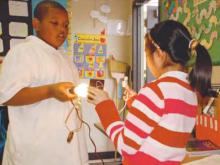Seeds of Science/Roots of Reading
Impact
Rigorous independent evaluations of Seeds/Roots shows that it has substantially raised students’ knowledge of science as well as their performance in reading and writing. One independent study found that 3rd and 4th graders receiving Seeds/Roots improved three times as fast as other students in the strength and clarity of their writing on science.
Accomplished
- Need Accomplished
- Evaluation Accomplished
- Sustainability Developing
- Replication & Scalability Accomplished
- Partnerships Accomplished
- Capacity Accomplished
- Challenging & Relevant Content Accomplished
- STEM Practices Accomplished
- Inspiration Accomplished
- Under-Represented Groups Developing

The data speaks for itself! There’s renewed enthusiasm that you can feel walking through the school…Teachers are commenting on how much background knowledge students are coming to them with, and they are able to take them farther than they ever have before.”
California charter school
Design Principles
The programs in this database clear a high bar. STEMworks reviewed each program against the Design Principles for Effective STEM Philanthropy. Programs must be Accomplished () across all Design Principles, or be Developing (
) in a maximum of three areas.
Overarching Principles
-
Need Accomplished
Identify and target a compelling and well-defined need.
-
Evaluation Accomplished
Use rigorous evaluation to continuously measure and inform progress towards the compelling need identified.
-
Sustainability Developing
Ensure work is sustainable.
-
Replication & Scalability Accomplished
Demonstrate replicability and scalability.
-
Partnerships Accomplished
Create high impact partnerships.
-
Capacity Accomplished
Ensure organizational capacity to achieve goals.
STEM Principles
-
Challenging & Relevant Content Accomplished
Offer challenging and relevant STEM content for the target audience.
-
STEM Practices Accomplished
Incorporate and encourage STEM practices.
-
Inspiration Accomplished
Inspire interest and engagement in STEM.
-
Under-Represented Groups Developing
Identify and address the needs of under-represented groups.
Program Overview
The Seeds/Roots program aims to immerse students in deep learning about the natural world. Students search for evidence from both firsthand experiences and texts to construct more accurate and complete understanding of the natural world. They engage in written and oral discourse to understand, communicate, evaluate, and revise scientific explanations based on evidence. The Seeds/Roots program is designed to be a core science program that addresses broad aspects of science proficiency while serving as a supplementary literacy program focused on non-fiction comprehension, vocabulary development, and fluency. The Seeds/Roots program takes on an equivalent number of learning goals in literacy and science, and it provides students with explicit instruction, opportunities to practice, and increasing independence in using literacy strategies to make sense of and communicate about the natural world. Though the Seeds/Roots program targets all students in public school classrooms nationwide, it also aims to address the needs of the fastest growing sector of the K-12 student population, English Language Learners. Seeds of Science/Roots of Reading is an integrated science and literacy curriculum program for students in Grades 2 through 5. The program was developed jointly by the University of California-Berkeley’s Lawrence Hall of Science and Graduate School of Education.
Funders and Partners
National Science Foundation, The Noyce Foundation